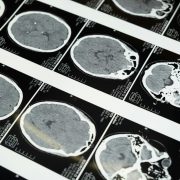Health
Why are Americans so sick? Researchers point to middle grocery aisles.
Obesity and disease rising with consumption of ultra-processed foods, say Chan School panelists
According to the Centers for Disease Control, more than 40 percent of Americans are obese, and many struggle with comorbidities such as Type 2 diabetes, heart disease, and cancer.
What is making us so sick? The ultra-processed foods that make up the bulk of the American diet are among the major culprits, according to an online panel hosted by Harvard’s T.H. Chan School of Public Health last week.
Experts from Harvard and the National Institutes of Health joined journalist Larissa Zimberoff, author of “Technically Food: Inside Silicon Valley’s Mission to Change What We Eat,” to discuss why the processing of cereals, breads, and other items typically found in the middle aisles of the grocery store — may be driving American weight gain.
Kevin Hall, senior investigator at the National Institute of Diabetes and Digestive and Kidney Diseases at the NIH, said initial research into diets high in ultra-processed foods shows strong links to overconsumption of calories.
Participants in a study conducted by Hall and his team published in 2019 were randomized to receive either ultra-processed or unprocessed diets for two weeks, immediately followed by the alternate diet for two weeks.
“But despite our diets being matched for various nutrients of concern, what we found was that people consuming the ultra-processed foods ate about 500 calories per day more over the two weeks that they were on that diet as compared to the minimally processed diet,” Hall said. “They gained weight and gained body fat. And when they were on the minimally processed diet, they spontaneously lost weight and lost body fat.”
According to Hall, “ultra-processed foods are one of the four categories of something called the NOVA classification system” developed by the School of Public Health at the University of São Paulo, Brazil.
NOVA food classification system
Examples:
Natural, packaged, cut, chilled, or frozen vegetables; fruits, potatoes, and other roots and tubers
Nuts, peanuts, and other seeds without salt or sugar
Bulk or packaged grains such as brown, white, parboiled, and wholegrain rice, corn kernel, or wheat berry
Fresh and dried herbs and spices (e.g., oregano, pepper, thyme,
cinnamon)
Fresh or pasteurized vegetable or fruit juices with no added sugar or other substances
Fresh and dried mushrooms and other fungi or algae
Grains of wheat, oats and other cereals
Fresh and dried herbs and spices
Grits, flakes and flours made from corn, wheat or oats, including those fortified with iron, folic acid or other nutrients lost during processing
Fresh, chilled or frozen meat, poultry, fish, and seafood, whole or in the form of steaks, fillets and other cuts
Dried or fresh pasta, couscous, and polenta made from water and the grits/flakes/flours described above
Fresh or pasteurized milk; yogurt without sugar
Eggs
Tea, herbal infusions
Lentils, chickpeas, beans, and other legumes
Coffee
Dried fruits
Examples:
Oils made from seeds, nuts and fruits, to include soybeans, corn, oil palm, sunflower, or olives
Butter
White, brown, and other types of sugar, and molasses obtained from cane or beet
Lard
Honey extracted from honeycombs
Coconut fat
Syrup extracted from maple trees
Refined or coarse salt, mined or from seawater
Starches extracted from corn and other plants
Any food combining two of these, such as “salted butter”
Examples:
Canned or bottled legumes or vegetables preserved in salt (brine) or vinegar, or by pickling
Canned fish, such as sardine and tuna, with or without added preservatives
Tomato extract, pastes or concentrates (with salt and/or sugar)
Tomato extract, pastes or concentrates (with salt and/or sugar)
Salted, dried, smoked, or cured meat, or fish
Fruits in sugar syrup (with or without added antioxidants)
Coconut fat
Beef jerky
Freshly made cheeses
Bacon
Freshly-made (unpackaged) breads made of wheat flour, yeast, water, and salt
Salted or sugared nuts and seeds
Fermented alcoholic beverages such as beer, alcoholic cider, and wine
Examples:
Fatty, sweet, savory or salty packaged snacks
Pre-prepared (packaged) meat, fish, and vegetables
Biscuits (cookies)
Pre-prepared pizza and pasta dishes
Ice creams and frozen desserts
Pre-prepared burgers, hot dogs, sausages
Chocolates, candies, and confectionery in general
Pre-prepared poultry and fish “nuggets” and “sticks”’
Cola, soda and other carbonated soft drinks
Other animal products made from remnants
“Energy” and sports drinks
Packaged breads, hamburger and hot dog buns
Canned, packaged, dehydrated (powdered) and other “instant” soups,
noodles, sauces, desserts, drink mixes and seasonings
Baked products made with ingredients such as hydrogenated vegetable fat, sugar, yeast, whey, emulsifiers, and other additives
Sweetened and flavored yogurts, including fruit yogurts
Breakfast cereals and bars
Dairy drinks, including chocolate milk
Infant formulas and drinks, and meal replacement shakes (e.g., “slim fast”)
Sweetened juices
Pastries, cakes, and cake mixes
Margarines and spreads
Distilled alcoholic beverages such as whisky, gin, rum, vodka, etc.
Manufacturing techniques to create ultra-processed foods include extrusion, molding, and preprocessing by frying. Panelist Jerold Mande, CEO of Nourish Science and an adjunct professor of nutrition at the Chan School who has previously held positions with the FDA and USDA, pointed out that foods like shelf-stable breads found at the grocery store are often no more than “very sophisticated emulsified foams.”
But Hall noted that not all ultra-processed foods are necessarily equally bad for you. His team is conducting a follow-up study that aims to look at different qualities of ultra-processed versus whole foods, including energy density, palatability, and portions.
“Those are only two potential mechanisms, the calories per gram of food — that’s the energy density of food — and the proportion of foods that have pairs of nutrients that cross certain thresholds, foods that are high in both sugar and fat, salt and fat, and salt and carbohydrates,” he said.
“We’re starting to see a little bit of that evidence that some ultra-processed foods might have a higher risk of disease and chronic disease than others,” said Josiemer Mattei, the Donald and Sue Pritzker Associate Professor of Nutrition at the Chan School.
Still, Mattei argued for lowering consumption across the board.
“Higher consumption and higher intake of ultra-processed foods overall was associated with higher risk of eventually developing Type 2 diabetes, and more emerging evidence coming with cardiovascular disease, especially for coronary heart disease,” she said.
All the panelists agreed that obesity and negative health outcomes have risen alongside consumption of ultra-processed foods.
“We need to invest more in the science,” Mande said. “We need to make sure our regulatory agencies work, and we need to leverage the biggest programs.”




